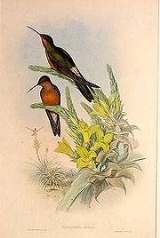
Giant Hummingbird
Encyclopedia
The Giant Hummingbird is the largest member of the hummingbird
family, weighing 18-24 g (6/10 - 8/10 of an ounce) and measuring approximately 21.5 cm (8½ in) in length. This is approximately the length same length as a European Starling
or a Northern Cardinal
, though the Giant Hummingbird is considerably lighter due to its more slender build and fairly long bill
. It is the only member
of the genus Patagona.
In Bolivia
, the Giant Hummingbird is known in Quechua as "burro q'enti". The Spanish word "burro
" refers to its dull, relatively unattractive plumage
compared to other locally occurring hummingbirds (e.g. Red-tailed Comet
).
of South America
, from far south-western Colombia
to central Chile
and Argentina
.
Hummingbird
Hummingbirds are birds that comprise the family Trochilidae. They are among the smallest of birds, most species measuring in the 7.5–13 cm range. Indeed, the smallest extant bird species is a hummingbird, the 5-cm Bee Hummingbird. They can hover in mid-air by rapidly flapping their wings...
family, weighing 18-24 g (6/10 - 8/10 of an ounce) and measuring approximately 21.5 cm (8½ in) in length. This is approximately the length same length as a European Starling
European Starling
The Common Starling , also known as the European Starling or just Starling, is a passerine bird in the family Sturnidae.This species of starling is native to most of temperate Europe and western Asia...
or a Northern Cardinal
Northern Cardinal
The Northern Cardinal or Redbird or Common Cardinal is a North American bird in the genus Cardinalis. It can be found in southern Canada, through the eastern United States from Maine to Texas and south through Mexico...
, though the Giant Hummingbird is considerably lighter due to its more slender build and fairly long bill
Beak
The beak, bill or rostrum is an external anatomical structure of birds which is used for eating and for grooming, manipulating objects, killing prey, fighting, probing for food, courtship and feeding young...
. It is the only member
Monotypic
In biology, a monotypic taxon is a taxonomic group with only one biological type. The term's usage differs slightly between botany and zoology. The term monotypic has a separate use in conservation biology, monotypic habitat, regarding species habitat conversion eliminating biodiversity and...
of the genus Patagona.
In Bolivia
Bolivia
Bolivia officially known as Plurinational State of Bolivia , is a landlocked country in central South America. It is the poorest country in South America...
, the Giant Hummingbird is known in Quechua as "burro q'enti". The Spanish word "burro
Burro
The burro is a small donkey used primarily as a pack animal. In addition, significant numbers of feral burros live in the Southwestern United States, where they are protected by law, and in Mexico...
" refers to its dull, relatively unattractive plumage
Plumage
Plumage refers both to the layer of feathers that cover a bird and the pattern, colour, and arrangement of those feathers. The pattern and colours of plumage vary between species and subspecies and can also vary between different age classes, sexes, and season. Within species there can also be a...
compared to other locally occurring hummingbirds (e.g. Red-tailed Comet
Red-tailed Comet
The Red-tailed Comet is a medium-sized hummingbird found in the central Andes of Bolivia and Argentina.-Description:...
).
Habitat
The Giant Hummingbird is found in rather arid open woodland and scrub between 2,000 and 4,300 meters (6,500-14,100 feet) above sea level in the AndesAndes
The Andes is the world's longest continental mountain range. It is a continual range of highlands along the western coast of South America. This range is about long, about to wide , and of an average height of about .Along its length, the Andes is split into several ranges, which are separated...
of South America
South America
South America is a continent situated in the Western Hemisphere, mostly in the Southern Hemisphere, with a relatively small portion in the Northern Hemisphere. The continent is also considered a subcontinent of the Americas. It is bordered on the west by the Pacific Ocean and on the north and east...
, from far south-western Colombia
Colombia
Colombia, officially the Republic of Colombia , is a unitary constitutional republic comprising thirty-two departments. The country is located in northwestern South America, bordered to the east by Venezuela and Brazil; to the south by Ecuador and Peru; to the north by the Caribbean Sea; to the...
to central Chile
Chile
Chile ,officially the Republic of Chile , is a country in South America occupying a long, narrow coastal strip between the Andes mountains to the east and the Pacific Ocean to the west. It borders Peru to the north, Bolivia to the northeast, Argentina to the east, and the Drake Passage in the far...
and Argentina
Argentina
Argentina , officially the Argentine Republic , is the second largest country in South America by land area, after Brazil. It is constituted as a federation of 23 provinces and an autonomous city, Buenos Aires...
.
Global range and population
The range of P. gigas is rather large, and its global Extent of Occurrence is estimated at 1,200,000 km2. Its global population is believed to be not less than 10,000 adults.External links
- Giant Hummingbird videos on the Internet Bird Collection
- BirdLife Species Factsheet
- - photographs of this and other hummingbird species
- Giant Hummingbird photo gallery VIREO
- Photo-Med Res; Article borderland-tours

